Report: Innovation and Commercialisation in the Hospitality Sector
VerifiedAdded on 2020/10/04
|20
|4989
|471
Report
AI Summary
This report provides a comprehensive analysis of innovation and commercialization strategies within Travelodge Hotels Limited. It begins by differentiating between innovation and invention, emphasizing the importance of innovation for business growth in a competitive environment. The report examines the role of leadership, organizational culture, and teamwork in shaping innovation and commercialization, highlighting how Travelodge fosters creativity and collaboration. It explores various sources of innovation and the application of the innovation funnel, including the 4Ps of innovation (product, process, position, and paradigm). The report also delves into frugal innovation, discussing its developments and implementation within Travelodge. Furthermore, it evaluates the commercialization process, including the significance of the commercial funnel and new product development (NPD). The report also covers the innovation business case and methods to access funds. Finally, it addresses the tools for managing knowledge and intellectual property, offering insights into protecting innovative ideas and overcoming challenges in innovation development. The report concludes with a summary of the findings and references.
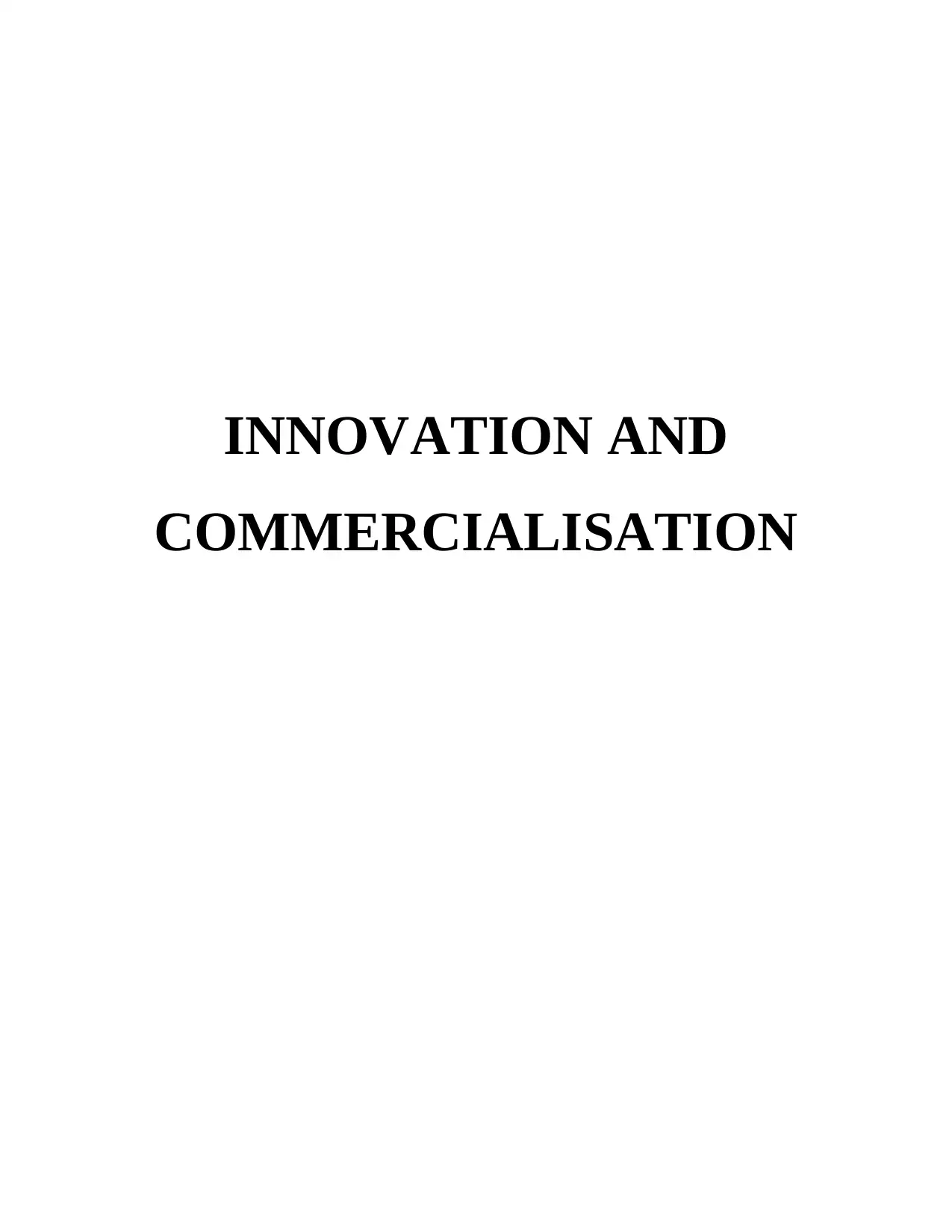
INNOVATION AND
COMMERCIALISATION
COMMERCIALISATION
Paraphrase This Document
Need a fresh take? Get an instant paraphrase of this document with our AI Paraphraser
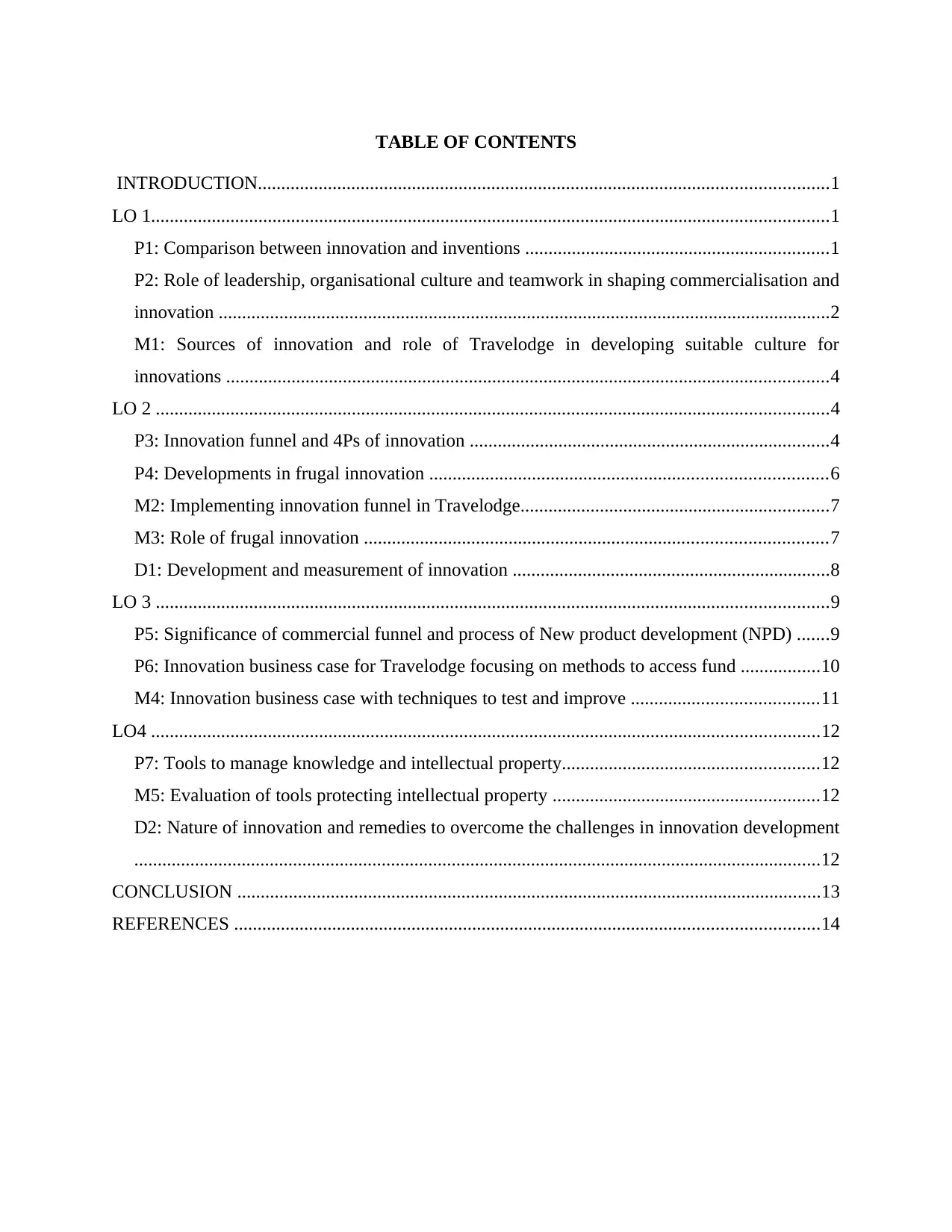
TABLE OF CONTENTS
INTRODUCTION..........................................................................................................................1
LO 1.................................................................................................................................................1
P1: Comparison between innovation and inventions .................................................................1
P2: Role of leadership, organisational culture and teamwork in shaping commercialisation and
innovation ...................................................................................................................................2
M1: Sources of innovation and role of Travelodge in developing suitable culture for
innovations .................................................................................................................................4
LO 2 ................................................................................................................................................4
P3: Innovation funnel and 4Ps of innovation .............................................................................4
P4: Developments in frugal innovation .....................................................................................6
M2: Implementing innovation funnel in Travelodge..................................................................7
M3: Role of frugal innovation ...................................................................................................7
D1: Development and measurement of innovation ....................................................................8
LO 3 ................................................................................................................................................9
P5: Significance of commercial funnel and process of New product development (NPD) .......9
P6: Innovation business case for Travelodge focusing on methods to access fund .................10
M4: Innovation business case with techniques to test and improve ........................................11
LO4 ...............................................................................................................................................12
P7: Tools to manage knowledge and intellectual property.......................................................12
M5: Evaluation of tools protecting intellectual property .........................................................12
D2: Nature of innovation and remedies to overcome the challenges in innovation development
...................................................................................................................................................12
CONCLUSION .............................................................................................................................13
REFERENCES .............................................................................................................................14
INTRODUCTION..........................................................................................................................1
LO 1.................................................................................................................................................1
P1: Comparison between innovation and inventions .................................................................1
P2: Role of leadership, organisational culture and teamwork in shaping commercialisation and
innovation ...................................................................................................................................2
M1: Sources of innovation and role of Travelodge in developing suitable culture for
innovations .................................................................................................................................4
LO 2 ................................................................................................................................................4
P3: Innovation funnel and 4Ps of innovation .............................................................................4
P4: Developments in frugal innovation .....................................................................................6
M2: Implementing innovation funnel in Travelodge..................................................................7
M3: Role of frugal innovation ...................................................................................................7
D1: Development and measurement of innovation ....................................................................8
LO 3 ................................................................................................................................................9
P5: Significance of commercial funnel and process of New product development (NPD) .......9
P6: Innovation business case for Travelodge focusing on methods to access fund .................10
M4: Innovation business case with techniques to test and improve ........................................11
LO4 ...............................................................................................................................................12
P7: Tools to manage knowledge and intellectual property.......................................................12
M5: Evaluation of tools protecting intellectual property .........................................................12
D2: Nature of innovation and remedies to overcome the challenges in innovation development
...................................................................................................................................................12
CONCLUSION .............................................................................................................................13
REFERENCES .............................................................................................................................14
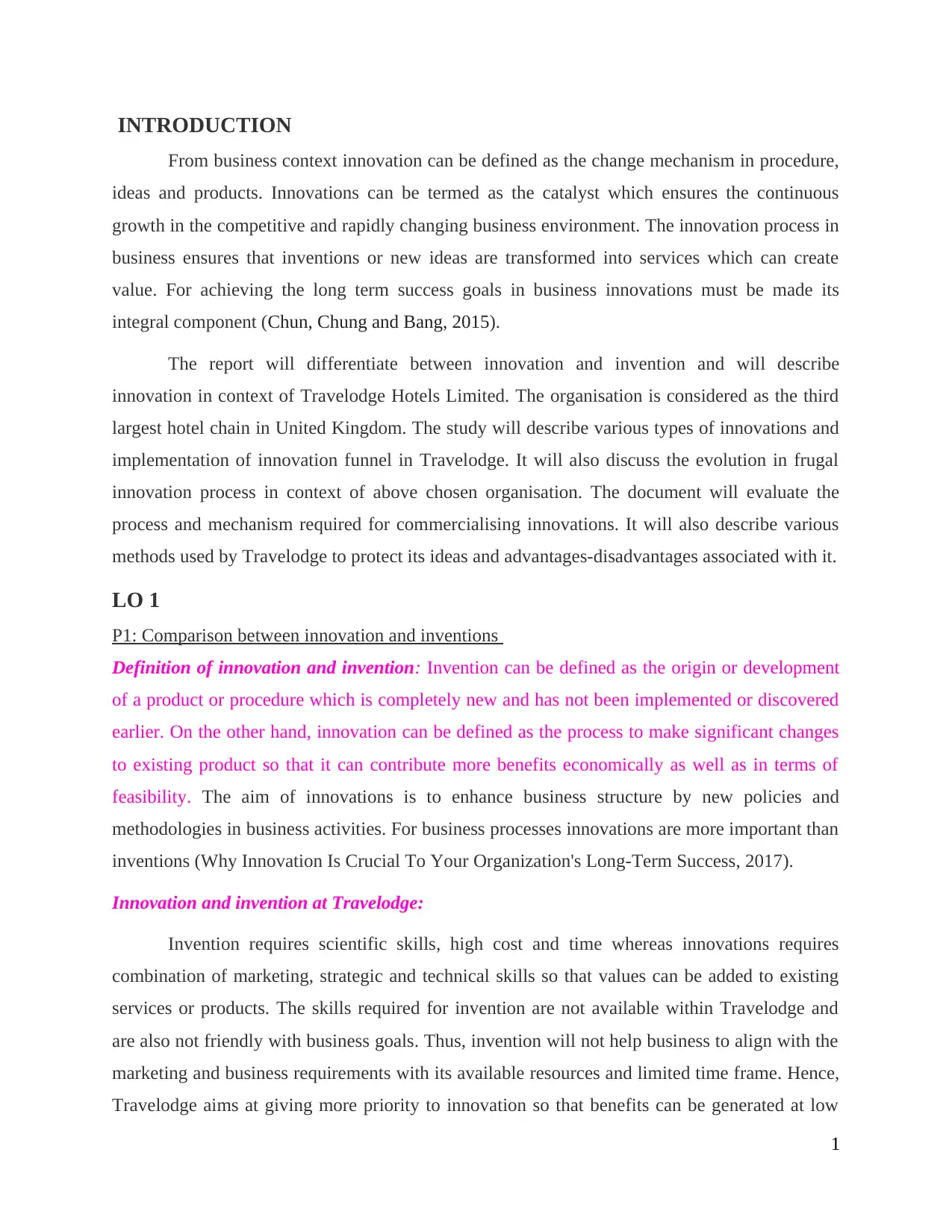
INTRODUCTION
From business context innovation can be defined as the change mechanism in procedure,
ideas and products. Innovations can be termed as the catalyst which ensures the continuous
growth in the competitive and rapidly changing business environment. The innovation process in
business ensures that inventions or new ideas are transformed into services which can create
value. For achieving the long term success goals in business innovations must be made its
integral component (Chun, Chung and Bang, 2015).
The report will differentiate between innovation and invention and will describe
innovation in context of Travelodge Hotels Limited. The organisation is considered as the third
largest hotel chain in United Kingdom. The study will describe various types of innovations and
implementation of innovation funnel in Travelodge. It will also discuss the evolution in frugal
innovation process in context of above chosen organisation. The document will evaluate the
process and mechanism required for commercialising innovations. It will also describe various
methods used by Travelodge to protect its ideas and advantages-disadvantages associated with it.
LO 1
P1: Comparison between innovation and inventions
Definition of innovation and invention: Invention can be defined as the origin or development
of a product or procedure which is completely new and has not been implemented or discovered
earlier. On the other hand, innovation can be defined as the process to make significant changes
to existing product so that it can contribute more benefits economically as well as in terms of
feasibility. The aim of innovations is to enhance business structure by new policies and
methodologies in business activities. For business processes innovations are more important than
inventions (Why Innovation Is Crucial To Your Organization's Long-Term Success, 2017).
Innovation and invention at Travelodge:
Invention requires scientific skills, high cost and time whereas innovations requires
combination of marketing, strategic and technical skills so that values can be added to existing
services or products. The skills required for invention are not available within Travelodge and
are also not friendly with business goals. Thus, invention will not help business to align with the
marketing and business requirements with its available resources and limited time frame. Hence,
Travelodge aims at giving more priority to innovation so that benefits can be generated at low
1
From business context innovation can be defined as the change mechanism in procedure,
ideas and products. Innovations can be termed as the catalyst which ensures the continuous
growth in the competitive and rapidly changing business environment. The innovation process in
business ensures that inventions or new ideas are transformed into services which can create
value. For achieving the long term success goals in business innovations must be made its
integral component (Chun, Chung and Bang, 2015).
The report will differentiate between innovation and invention and will describe
innovation in context of Travelodge Hotels Limited. The organisation is considered as the third
largest hotel chain in United Kingdom. The study will describe various types of innovations and
implementation of innovation funnel in Travelodge. It will also discuss the evolution in frugal
innovation process in context of above chosen organisation. The document will evaluate the
process and mechanism required for commercialising innovations. It will also describe various
methods used by Travelodge to protect its ideas and advantages-disadvantages associated with it.
LO 1
P1: Comparison between innovation and inventions
Definition of innovation and invention: Invention can be defined as the origin or development
of a product or procedure which is completely new and has not been implemented or discovered
earlier. On the other hand, innovation can be defined as the process to make significant changes
to existing product so that it can contribute more benefits economically as well as in terms of
feasibility. The aim of innovations is to enhance business structure by new policies and
methodologies in business activities. For business processes innovations are more important than
inventions (Why Innovation Is Crucial To Your Organization's Long-Term Success, 2017).
Innovation and invention at Travelodge:
Invention requires scientific skills, high cost and time whereas innovations requires
combination of marketing, strategic and technical skills so that values can be added to existing
services or products. The skills required for invention are not available within Travelodge and
are also not friendly with business goals. Thus, invention will not help business to align with the
marketing and business requirements with its available resources and limited time frame. Hence,
Travelodge aims at giving more priority to innovation so that benefits can be generated at low
1
⊘ This is a preview!⊘
Do you want full access?
Subscribe today to unlock all pages.

Trusted by 1+ million students worldwide
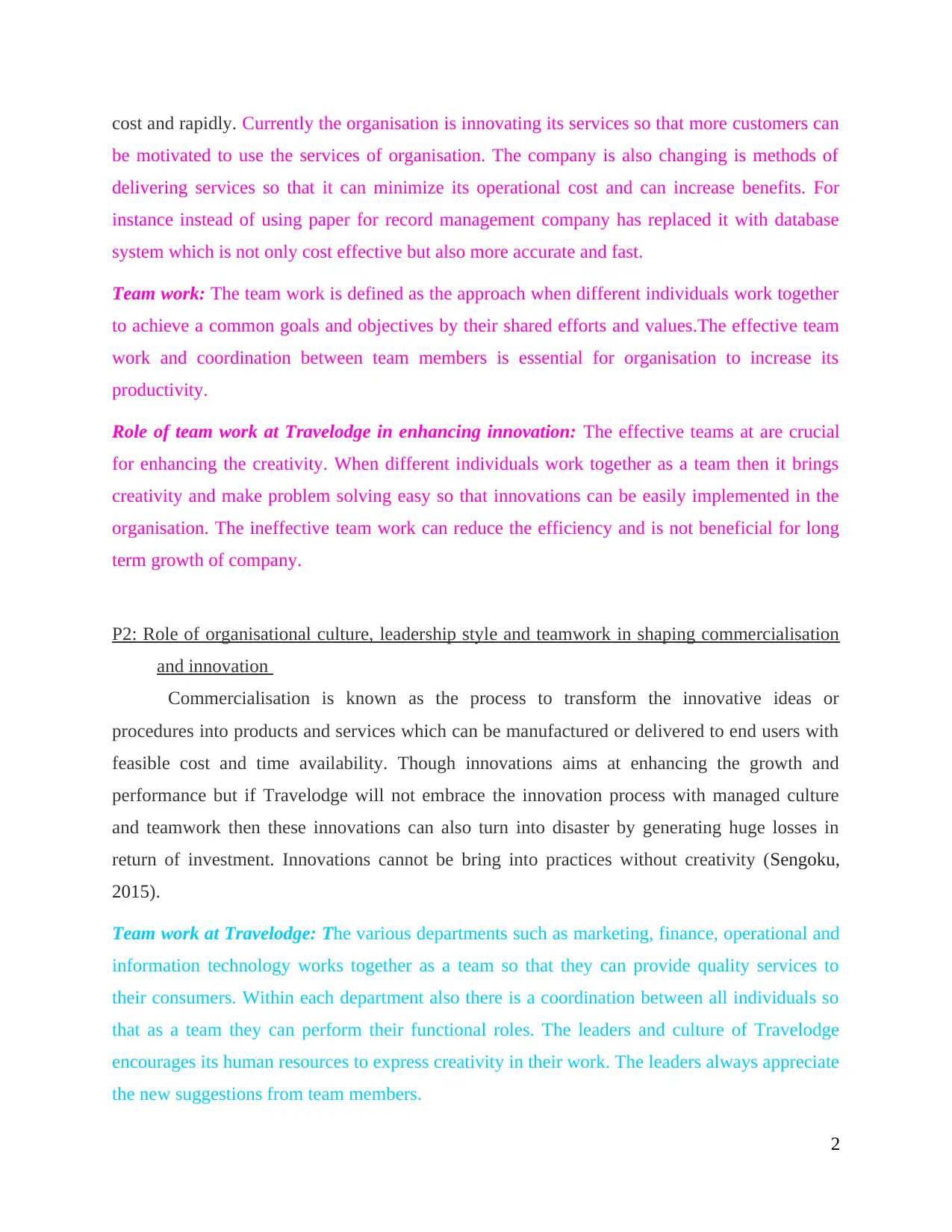
cost and rapidly. Currently the organisation is innovating its services so that more customers can
be motivated to use the services of organisation. The company is also changing is methods of
delivering services so that it can minimize its operational cost and can increase benefits. For
instance instead of using paper for record management company has replaced it with database
system which is not only cost effective but also more accurate and fast.
Team work: The team work is defined as the approach when different individuals work together
to achieve a common goals and objectives by their shared efforts and values.The effective team
work and coordination between team members is essential for organisation to increase its
productivity.
Role of team work at Travelodge in enhancing innovation: The effective teams at are crucial
for enhancing the creativity. When different individuals work together as a team then it brings
creativity and make problem solving easy so that innovations can be easily implemented in the
organisation. The ineffective team work can reduce the efficiency and is not beneficial for long
term growth of company.
P2: Role of organisational culture, leadership style and teamwork in shaping commercialisation
and innovation
Commercialisation is known as the process to transform the innovative ideas or
procedures into products and services which can be manufactured or delivered to end users with
feasible cost and time availability. Though innovations aims at enhancing the growth and
performance but if Travelodge will not embrace the innovation process with managed culture
and teamwork then these innovations can also turn into disaster by generating huge losses in
return of investment. Innovations cannot be bring into practices without creativity (Sengoku,
2015).
Team work at Travelodge: The various departments such as marketing, finance, operational and
information technology works together as a team so that they can provide quality services to
their consumers. Within each department also there is a coordination between all individuals so
that as a team they can perform their functional roles. The leaders and culture of Travelodge
encourages its human resources to express creativity in their work. The leaders always appreciate
the new suggestions from team members.
2
be motivated to use the services of organisation. The company is also changing is methods of
delivering services so that it can minimize its operational cost and can increase benefits. For
instance instead of using paper for record management company has replaced it with database
system which is not only cost effective but also more accurate and fast.
Team work: The team work is defined as the approach when different individuals work together
to achieve a common goals and objectives by their shared efforts and values.The effective team
work and coordination between team members is essential for organisation to increase its
productivity.
Role of team work at Travelodge in enhancing innovation: The effective teams at are crucial
for enhancing the creativity. When different individuals work together as a team then it brings
creativity and make problem solving easy so that innovations can be easily implemented in the
organisation. The ineffective team work can reduce the efficiency and is not beneficial for long
term growth of company.
P2: Role of organisational culture, leadership style and teamwork in shaping commercialisation
and innovation
Commercialisation is known as the process to transform the innovative ideas or
procedures into products and services which can be manufactured or delivered to end users with
feasible cost and time availability. Though innovations aims at enhancing the growth and
performance but if Travelodge will not embrace the innovation process with managed culture
and teamwork then these innovations can also turn into disaster by generating huge losses in
return of investment. Innovations cannot be bring into practices without creativity (Sengoku,
2015).
Team work at Travelodge: The various departments such as marketing, finance, operational and
information technology works together as a team so that they can provide quality services to
their consumers. Within each department also there is a coordination between all individuals so
that as a team they can perform their functional roles. The leaders and culture of Travelodge
encourages its human resources to express creativity in their work. The leaders always appreciate
the new suggestions from team members.
2
Paraphrase This Document
Need a fresh take? Get an instant paraphrase of this document with our AI Paraphraser
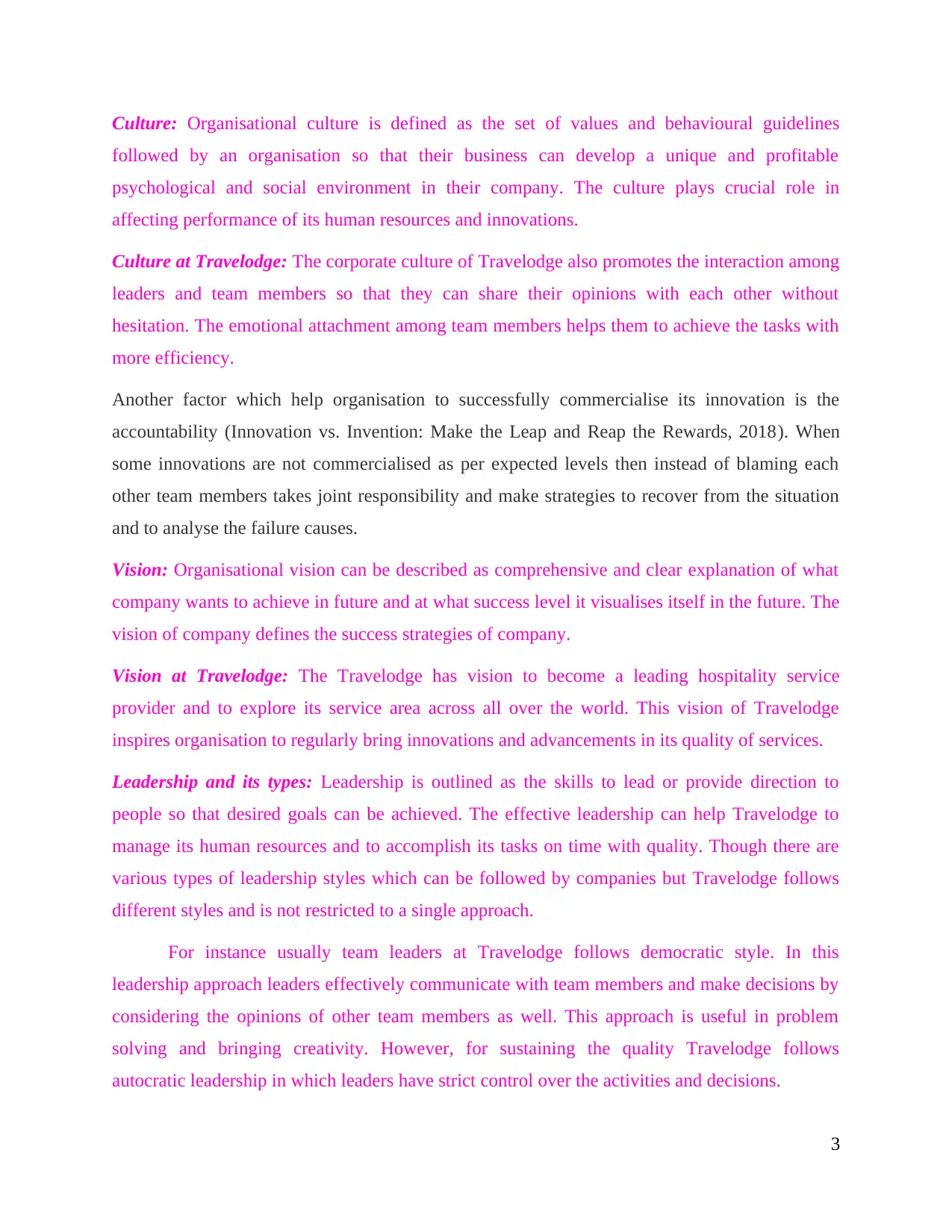
Culture: Organisational culture is defined as the set of values and behavioural guidelines
followed by an organisation so that their business can develop a unique and profitable
psychological and social environment in their company. The culture plays crucial role in
affecting performance of its human resources and innovations.
Culture at Travelodge: The corporate culture of Travelodge also promotes the interaction among
leaders and team members so that they can share their opinions with each other without
hesitation. The emotional attachment among team members helps them to achieve the tasks with
more efficiency.
Another factor which help organisation to successfully commercialise its innovation is the
accountability (Innovation vs. Invention: Make the Leap and Reap the Rewards, 2018). When
some innovations are not commercialised as per expected levels then instead of blaming each
other team members takes joint responsibility and make strategies to recover from the situation
and to analyse the failure causes.
Vision: Organisational vision can be described as comprehensive and clear explanation of what
company wants to achieve in future and at what success level it visualises itself in the future. The
vision of company defines the success strategies of company.
Vision at Travelodge: The Travelodge has vision to become a leading hospitality service
provider and to explore its service area across all over the world. This vision of Travelodge
inspires organisation to regularly bring innovations and advancements in its quality of services.
Leadership and its types: Leadership is outlined as the skills to lead or provide direction to
people so that desired goals can be achieved. The effective leadership can help Travelodge to
manage its human resources and to accomplish its tasks on time with quality. Though there are
various types of leadership styles which can be followed by companies but Travelodge follows
different styles and is not restricted to a single approach.
For instance usually team leaders at Travelodge follows democratic style. In this
leadership approach leaders effectively communicate with team members and make decisions by
considering the opinions of other team members as well. This approach is useful in problem
solving and bringing creativity. However, for sustaining the quality Travelodge follows
autocratic leadership in which leaders have strict control over the activities and decisions.
3
followed by an organisation so that their business can develop a unique and profitable
psychological and social environment in their company. The culture plays crucial role in
affecting performance of its human resources and innovations.
Culture at Travelodge: The corporate culture of Travelodge also promotes the interaction among
leaders and team members so that they can share their opinions with each other without
hesitation. The emotional attachment among team members helps them to achieve the tasks with
more efficiency.
Another factor which help organisation to successfully commercialise its innovation is the
accountability (Innovation vs. Invention: Make the Leap and Reap the Rewards, 2018). When
some innovations are not commercialised as per expected levels then instead of blaming each
other team members takes joint responsibility and make strategies to recover from the situation
and to analyse the failure causes.
Vision: Organisational vision can be described as comprehensive and clear explanation of what
company wants to achieve in future and at what success level it visualises itself in the future. The
vision of company defines the success strategies of company.
Vision at Travelodge: The Travelodge has vision to become a leading hospitality service
provider and to explore its service area across all over the world. This vision of Travelodge
inspires organisation to regularly bring innovations and advancements in its quality of services.
Leadership and its types: Leadership is outlined as the skills to lead or provide direction to
people so that desired goals can be achieved. The effective leadership can help Travelodge to
manage its human resources and to accomplish its tasks on time with quality. Though there are
various types of leadership styles which can be followed by companies but Travelodge follows
different styles and is not restricted to a single approach.
For instance usually team leaders at Travelodge follows democratic style. In this
leadership approach leaders effectively communicate with team members and make decisions by
considering the opinions of other team members as well. This approach is useful in problem
solving and bringing creativity. However, for sustaining the quality Travelodge follows
autocratic leadership in which leaders have strict control over the activities and decisions.
3
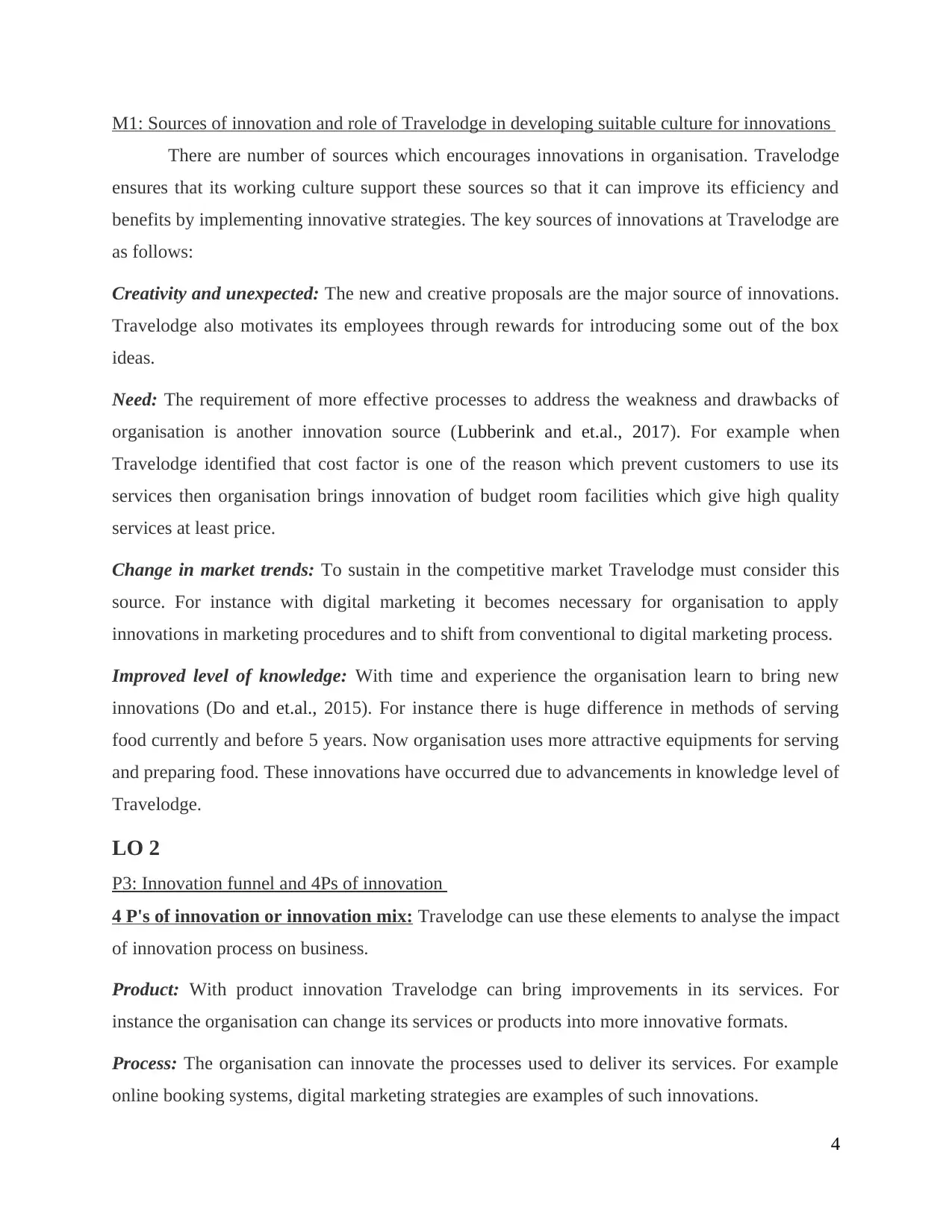
M1: Sources of innovation and role of Travelodge in developing suitable culture for innovations
There are number of sources which encourages innovations in organisation. Travelodge
ensures that its working culture support these sources so that it can improve its efficiency and
benefits by implementing innovative strategies. The key sources of innovations at Travelodge are
as follows:
Creativity and unexpected: The new and creative proposals are the major source of innovations.
Travelodge also motivates its employees through rewards for introducing some out of the box
ideas.
Need: The requirement of more effective processes to address the weakness and drawbacks of
organisation is another innovation source (Lubberink and et.al., 2017). For example when
Travelodge identified that cost factor is one of the reason which prevent customers to use its
services then organisation brings innovation of budget room facilities which give high quality
services at least price.
Change in market trends: To sustain in the competitive market Travelodge must consider this
source. For instance with digital marketing it becomes necessary for organisation to apply
innovations in marketing procedures and to shift from conventional to digital marketing process.
Improved level of knowledge: With time and experience the organisation learn to bring new
innovations (Do and et.al., 2015). For instance there is huge difference in methods of serving
food currently and before 5 years. Now organisation uses more attractive equipments for serving
and preparing food. These innovations have occurred due to advancements in knowledge level of
Travelodge.
LO 2
P3: Innovation funnel and 4Ps of innovation
4 P's of innovation or innovation mix: Travelodge can use these elements to analyse the impact
of innovation process on business.
Product: With product innovation Travelodge can bring improvements in its services. For
instance the organisation can change its services or products into more innovative formats.
Process: The organisation can innovate the processes used to deliver its services. For example
online booking systems, digital marketing strategies are examples of such innovations.
4
There are number of sources which encourages innovations in organisation. Travelodge
ensures that its working culture support these sources so that it can improve its efficiency and
benefits by implementing innovative strategies. The key sources of innovations at Travelodge are
as follows:
Creativity and unexpected: The new and creative proposals are the major source of innovations.
Travelodge also motivates its employees through rewards for introducing some out of the box
ideas.
Need: The requirement of more effective processes to address the weakness and drawbacks of
organisation is another innovation source (Lubberink and et.al., 2017). For example when
Travelodge identified that cost factor is one of the reason which prevent customers to use its
services then organisation brings innovation of budget room facilities which give high quality
services at least price.
Change in market trends: To sustain in the competitive market Travelodge must consider this
source. For instance with digital marketing it becomes necessary for organisation to apply
innovations in marketing procedures and to shift from conventional to digital marketing process.
Improved level of knowledge: With time and experience the organisation learn to bring new
innovations (Do and et.al., 2015). For instance there is huge difference in methods of serving
food currently and before 5 years. Now organisation uses more attractive equipments for serving
and preparing food. These innovations have occurred due to advancements in knowledge level of
Travelodge.
LO 2
P3: Innovation funnel and 4Ps of innovation
4 P's of innovation or innovation mix: Travelodge can use these elements to analyse the impact
of innovation process on business.
Product: With product innovation Travelodge can bring improvements in its services. For
instance the organisation can change its services or products into more innovative formats.
Process: The organisation can innovate the processes used to deliver its services. For example
online booking systems, digital marketing strategies are examples of such innovations.
4
⊘ This is a preview!⊘
Do you want full access?
Subscribe today to unlock all pages.

Trusted by 1+ million students worldwide
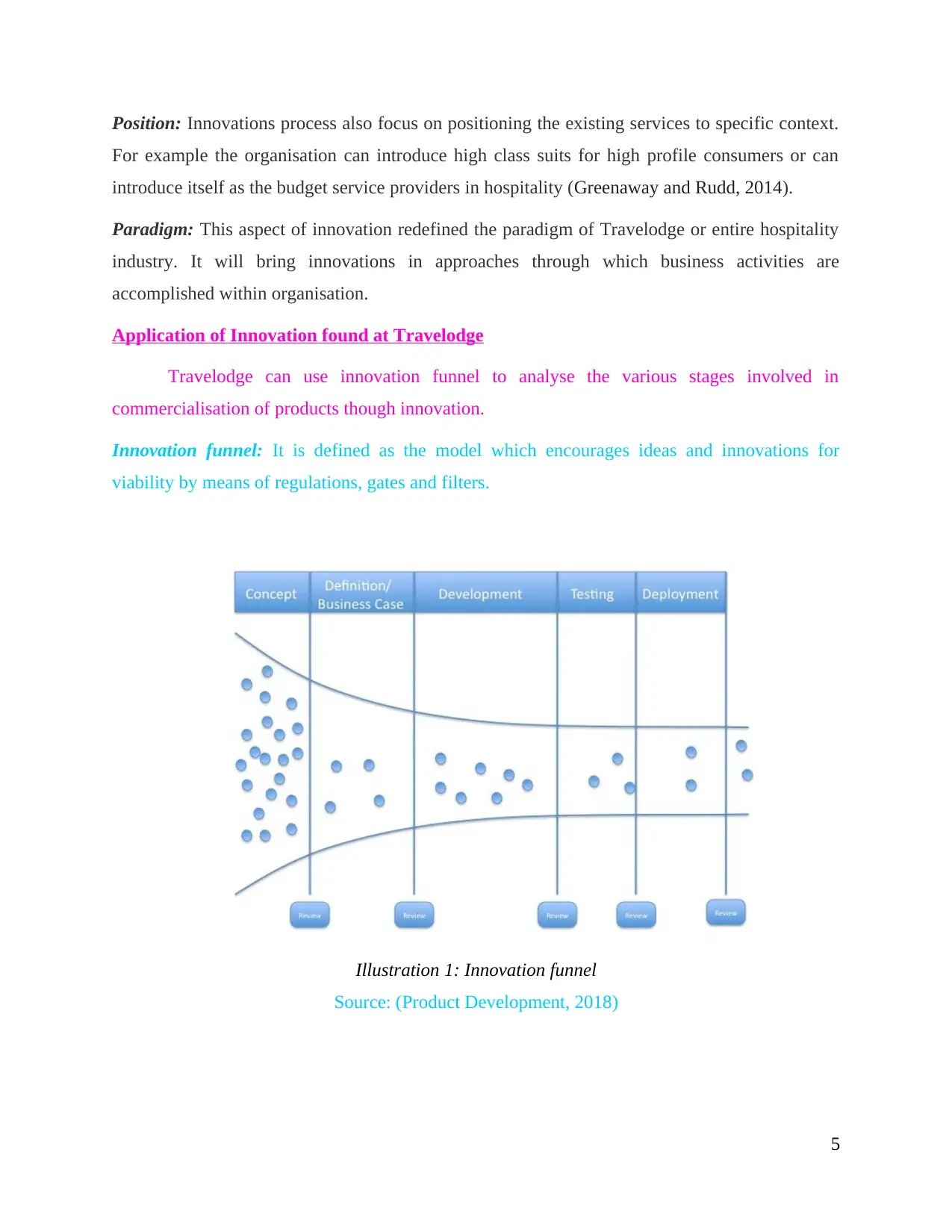
Position: Innovations process also focus on positioning the existing services to specific context.
For example the organisation can introduce high class suits for high profile consumers or can
introduce itself as the budget service providers in hospitality (Greenaway and Rudd, 2014).
Paradigm: This aspect of innovation redefined the paradigm of Travelodge or entire hospitality
industry. It will bring innovations in approaches through which business activities are
accomplished within organisation.
Application of Innovation found at Travelodge
Travelodge can use innovation funnel to analyse the various stages involved in
commercialisation of products though innovation.
Innovation funnel: It is defined as the model which encourages ideas and innovations for
viability by means of regulations, gates and filters.
Source: (Product Development, 2018)
5
Illustration 1: Innovation funnel
For example the organisation can introduce high class suits for high profile consumers or can
introduce itself as the budget service providers in hospitality (Greenaway and Rudd, 2014).
Paradigm: This aspect of innovation redefined the paradigm of Travelodge or entire hospitality
industry. It will bring innovations in approaches through which business activities are
accomplished within organisation.
Application of Innovation found at Travelodge
Travelodge can use innovation funnel to analyse the various stages involved in
commercialisation of products though innovation.
Innovation funnel: It is defined as the model which encourages ideas and innovations for
viability by means of regulations, gates and filters.
Source: (Product Development, 2018)
5
Illustration 1: Innovation funnel
Paraphrase This Document
Need a fresh take? Get an instant paraphrase of this document with our AI Paraphraser
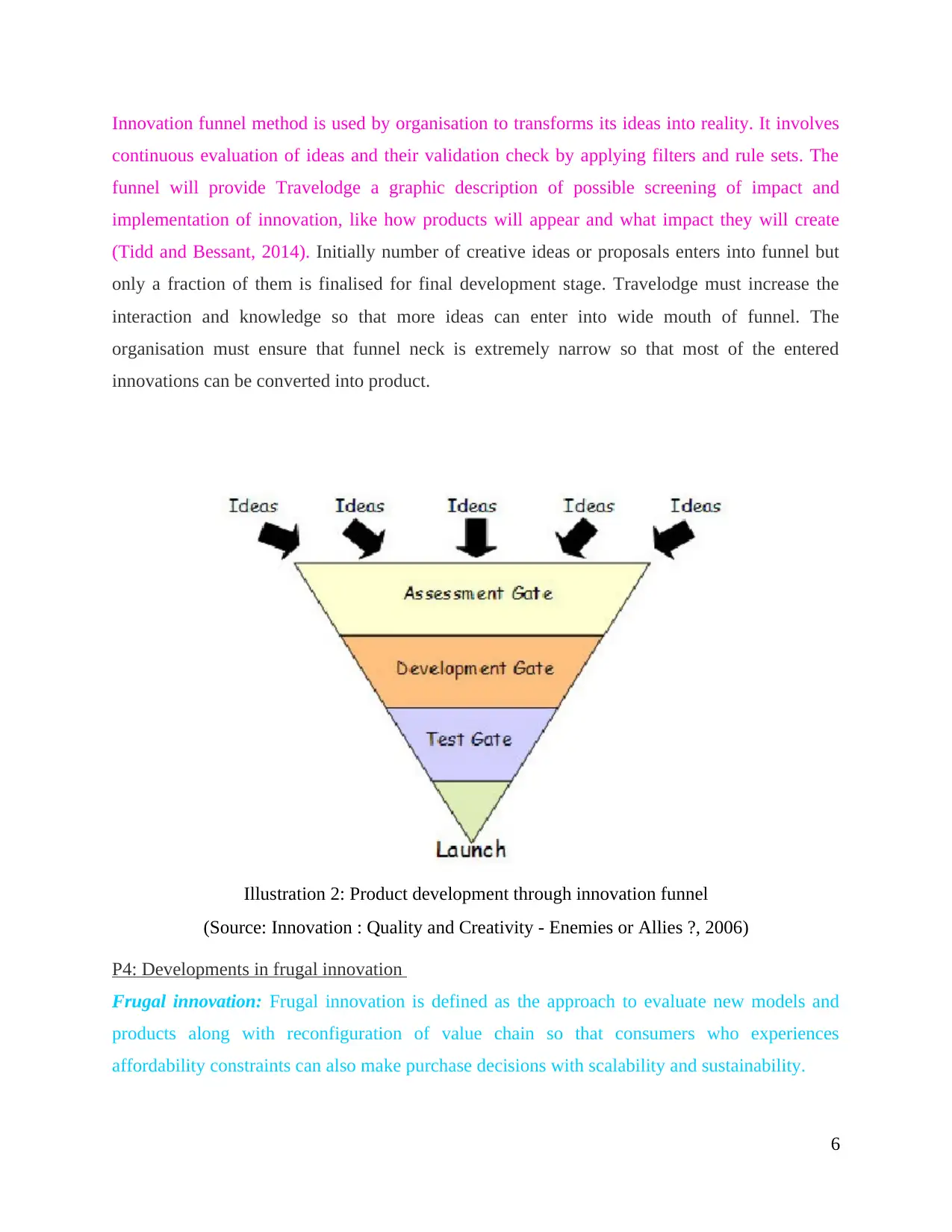
Innovation funnel method is used by organisation to transforms its ideas into reality. It involves
continuous evaluation of ideas and their validation check by applying filters and rule sets. The
funnel will provide Travelodge a graphic description of possible screening of impact and
implementation of innovation, like how products will appear and what impact they will create
(Tidd and Bessant, 2014). Initially number of creative ideas or proposals enters into funnel but
only a fraction of them is finalised for final development stage. Travelodge must increase the
interaction and knowledge so that more ideas can enter into wide mouth of funnel. The
organisation must ensure that funnel neck is extremely narrow so that most of the entered
innovations can be converted into product.
(Source: Innovation : Quality and Creativity - Enemies or Allies ?, 2006)
P4: Developments in frugal innovation
Frugal innovation: Frugal innovation is defined as the approach to evaluate new models and
products along with reconfiguration of value chain so that consumers who experiences
affordability constraints can also make purchase decisions with scalability and sustainability.
6
Illustration 2: Product development through innovation funnel
continuous evaluation of ideas and their validation check by applying filters and rule sets. The
funnel will provide Travelodge a graphic description of possible screening of impact and
implementation of innovation, like how products will appear and what impact they will create
(Tidd and Bessant, 2014). Initially number of creative ideas or proposals enters into funnel but
only a fraction of them is finalised for final development stage. Travelodge must increase the
interaction and knowledge so that more ideas can enter into wide mouth of funnel. The
organisation must ensure that funnel neck is extremely narrow so that most of the entered
innovations can be converted into product.
(Source: Innovation : Quality and Creativity - Enemies or Allies ?, 2006)
P4: Developments in frugal innovation
Frugal innovation: Frugal innovation is defined as the approach to evaluate new models and
products along with reconfiguration of value chain so that consumers who experiences
affordability constraints can also make purchase decisions with scalability and sustainability.
6
Illustration 2: Product development through innovation funnel
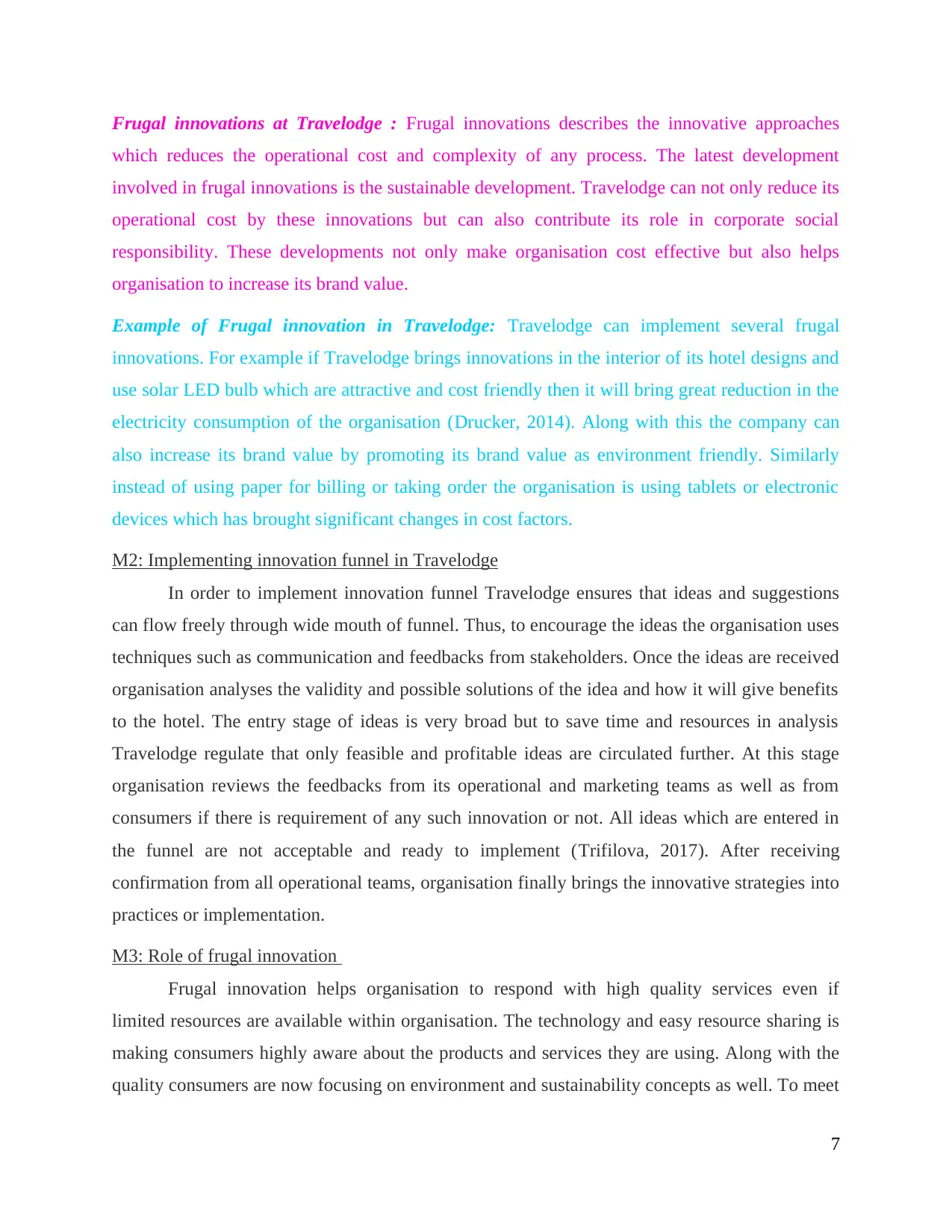
Frugal innovations at Travelodge : Frugal innovations describes the innovative approaches
which reduces the operational cost and complexity of any process. The latest development
involved in frugal innovations is the sustainable development. Travelodge can not only reduce its
operational cost by these innovations but can also contribute its role in corporate social
responsibility. These developments not only make organisation cost effective but also helps
organisation to increase its brand value.
Example of Frugal innovation in Travelodge: Travelodge can implement several frugal
innovations. For example if Travelodge brings innovations in the interior of its hotel designs and
use solar LED bulb which are attractive and cost friendly then it will bring great reduction in the
electricity consumption of the organisation (Drucker, 2014). Along with this the company can
also increase its brand value by promoting its brand value as environment friendly. Similarly
instead of using paper for billing or taking order the organisation is using tablets or electronic
devices which has brought significant changes in cost factors.
M2: Implementing innovation funnel in Travelodge
In order to implement innovation funnel Travelodge ensures that ideas and suggestions
can flow freely through wide mouth of funnel. Thus, to encourage the ideas the organisation uses
techniques such as communication and feedbacks from stakeholders. Once the ideas are received
organisation analyses the validity and possible solutions of the idea and how it will give benefits
to the hotel. The entry stage of ideas is very broad but to save time and resources in analysis
Travelodge regulate that only feasible and profitable ideas are circulated further. At this stage
organisation reviews the feedbacks from its operational and marketing teams as well as from
consumers if there is requirement of any such innovation or not. All ideas which are entered in
the funnel are not acceptable and ready to implement (Trifilova, 2017). After receiving
confirmation from all operational teams, organisation finally brings the innovative strategies into
practices or implementation.
M3: Role of frugal innovation
Frugal innovation helps organisation to respond with high quality services even if
limited resources are available within organisation. The technology and easy resource sharing is
making consumers highly aware about the products and services they are using. Along with the
quality consumers are now focusing on environment and sustainability concepts as well. To meet
7
which reduces the operational cost and complexity of any process. The latest development
involved in frugal innovations is the sustainable development. Travelodge can not only reduce its
operational cost by these innovations but can also contribute its role in corporate social
responsibility. These developments not only make organisation cost effective but also helps
organisation to increase its brand value.
Example of Frugal innovation in Travelodge: Travelodge can implement several frugal
innovations. For example if Travelodge brings innovations in the interior of its hotel designs and
use solar LED bulb which are attractive and cost friendly then it will bring great reduction in the
electricity consumption of the organisation (Drucker, 2014). Along with this the company can
also increase its brand value by promoting its brand value as environment friendly. Similarly
instead of using paper for billing or taking order the organisation is using tablets or electronic
devices which has brought significant changes in cost factors.
M2: Implementing innovation funnel in Travelodge
In order to implement innovation funnel Travelodge ensures that ideas and suggestions
can flow freely through wide mouth of funnel. Thus, to encourage the ideas the organisation uses
techniques such as communication and feedbacks from stakeholders. Once the ideas are received
organisation analyses the validity and possible solutions of the idea and how it will give benefits
to the hotel. The entry stage of ideas is very broad but to save time and resources in analysis
Travelodge regulate that only feasible and profitable ideas are circulated further. At this stage
organisation reviews the feedbacks from its operational and marketing teams as well as from
consumers if there is requirement of any such innovation or not. All ideas which are entered in
the funnel are not acceptable and ready to implement (Trifilova, 2017). After receiving
confirmation from all operational teams, organisation finally brings the innovative strategies into
practices or implementation.
M3: Role of frugal innovation
Frugal innovation helps organisation to respond with high quality services even if
limited resources are available within organisation. The technology and easy resource sharing is
making consumers highly aware about the products and services they are using. Along with the
quality consumers are now focusing on environment and sustainability concepts as well. To meet
7
⊘ This is a preview!⊘
Do you want full access?
Subscribe today to unlock all pages.

Trusted by 1+ million students worldwide
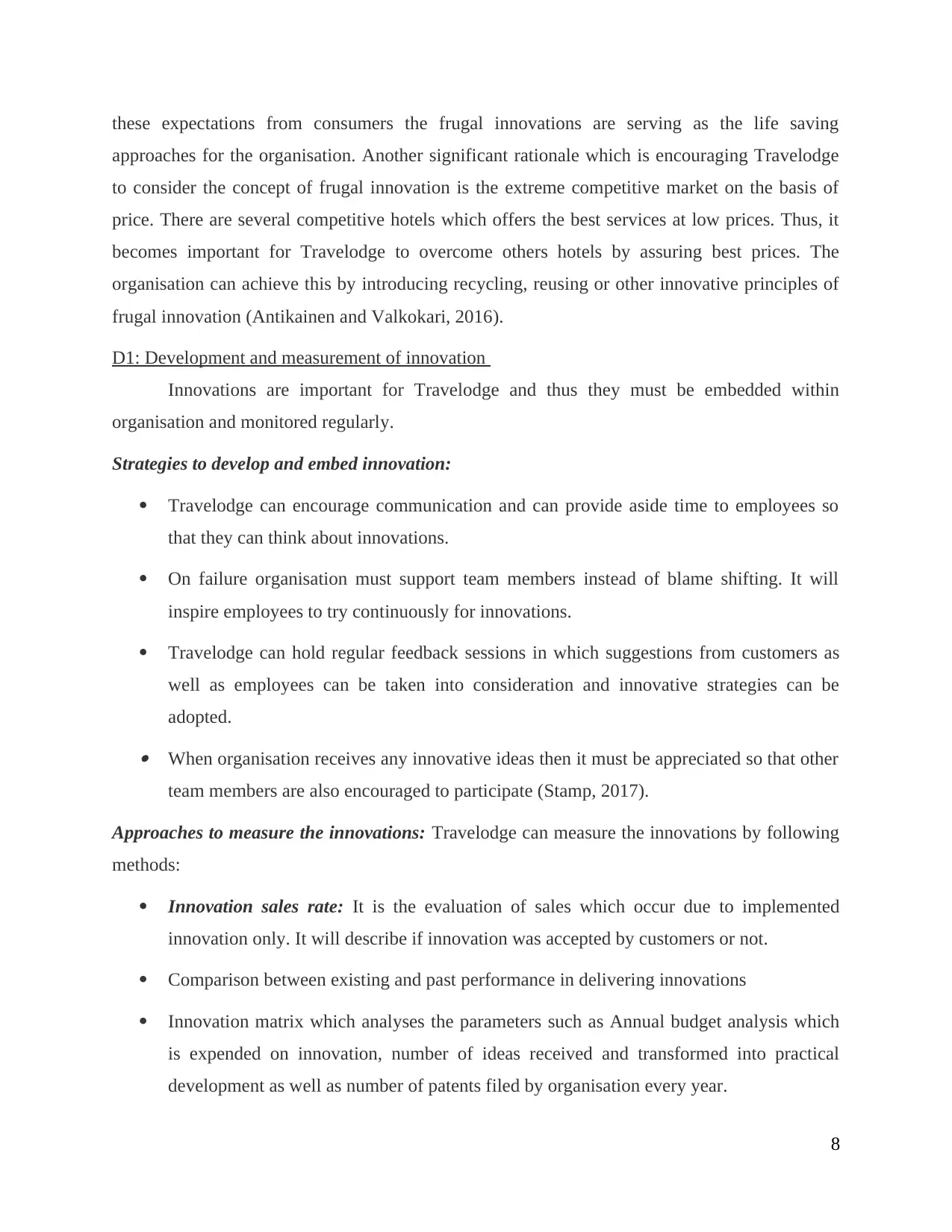
these expectations from consumers the frugal innovations are serving as the life saving
approaches for the organisation. Another significant rationale which is encouraging Travelodge
to consider the concept of frugal innovation is the extreme competitive market on the basis of
price. There are several competitive hotels which offers the best services at low prices. Thus, it
becomes important for Travelodge to overcome others hotels by assuring best prices. The
organisation can achieve this by introducing recycling, reusing or other innovative principles of
frugal innovation (Antikainen and Valkokari, 2016).
D1: Development and measurement of innovation
Innovations are important for Travelodge and thus they must be embedded within
organisation and monitored regularly.
Strategies to develop and embed innovation:
Travelodge can encourage communication and can provide aside time to employees so
that they can think about innovations.
On failure organisation must support team members instead of blame shifting. It will
inspire employees to try continuously for innovations.
Travelodge can hold regular feedback sessions in which suggestions from customers as
well as employees can be taken into consideration and innovative strategies can be
adopted. When organisation receives any innovative ideas then it must be appreciated so that other
team members are also encouraged to participate (Stamp, 2017).
Approaches to measure the innovations: Travelodge can measure the innovations by following
methods:
Innovation sales rate: It is the evaluation of sales which occur due to implemented
innovation only. It will describe if innovation was accepted by customers or not.
Comparison between existing and past performance in delivering innovations
Innovation matrix which analyses the parameters such as Annual budget analysis which
is expended on innovation, number of ideas received and transformed into practical
development as well as number of patents filed by organisation every year.
8
approaches for the organisation. Another significant rationale which is encouraging Travelodge
to consider the concept of frugal innovation is the extreme competitive market on the basis of
price. There are several competitive hotels which offers the best services at low prices. Thus, it
becomes important for Travelodge to overcome others hotels by assuring best prices. The
organisation can achieve this by introducing recycling, reusing or other innovative principles of
frugal innovation (Antikainen and Valkokari, 2016).
D1: Development and measurement of innovation
Innovations are important for Travelodge and thus they must be embedded within
organisation and monitored regularly.
Strategies to develop and embed innovation:
Travelodge can encourage communication and can provide aside time to employees so
that they can think about innovations.
On failure organisation must support team members instead of blame shifting. It will
inspire employees to try continuously for innovations.
Travelodge can hold regular feedback sessions in which suggestions from customers as
well as employees can be taken into consideration and innovative strategies can be
adopted. When organisation receives any innovative ideas then it must be appreciated so that other
team members are also encouraged to participate (Stamp, 2017).
Approaches to measure the innovations: Travelodge can measure the innovations by following
methods:
Innovation sales rate: It is the evaluation of sales which occur due to implemented
innovation only. It will describe if innovation was accepted by customers or not.
Comparison between existing and past performance in delivering innovations
Innovation matrix which analyses the parameters such as Annual budget analysis which
is expended on innovation, number of ideas received and transformed into practical
development as well as number of patents filed by organisation every year.
8
Paraphrase This Document
Need a fresh take? Get an instant paraphrase of this document with our AI Paraphraser
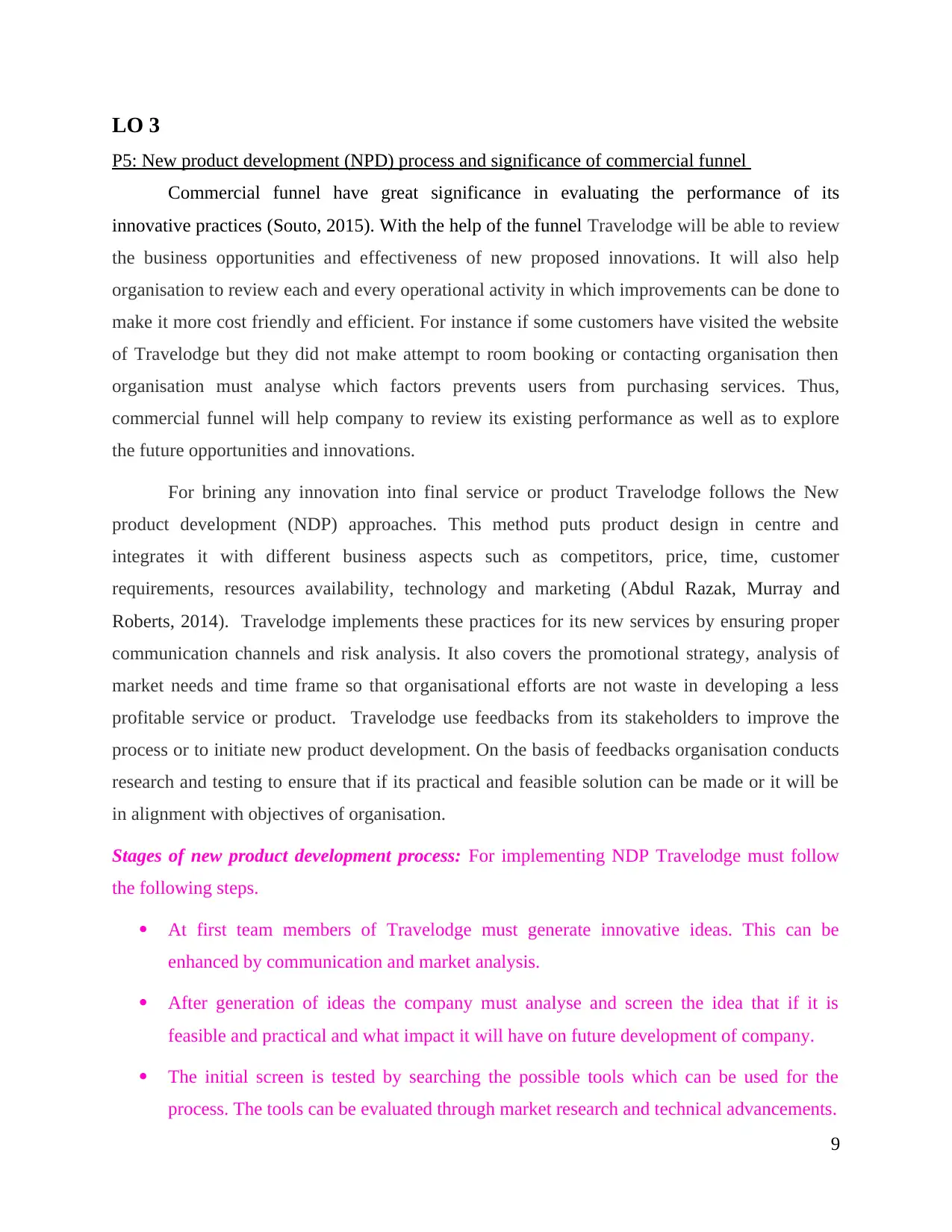
LO 3
P5: New product development (NPD) process and significance of commercial funnel
Commercial funnel have great significance in evaluating the performance of its
innovative practices (Souto, 2015). With the help of the funnel Travelodge will be able to review
the business opportunities and effectiveness of new proposed innovations. It will also help
organisation to review each and every operational activity in which improvements can be done to
make it more cost friendly and efficient. For instance if some customers have visited the website
of Travelodge but they did not make attempt to room booking or contacting organisation then
organisation must analyse which factors prevents users from purchasing services. Thus,
commercial funnel will help company to review its existing performance as well as to explore
the future opportunities and innovations.
For brining any innovation into final service or product Travelodge follows the New
product development (NDP) approaches. This method puts product design in centre and
integrates it with different business aspects such as competitors, price, time, customer
requirements, resources availability, technology and marketing (Abdul Razak, Murray and
Roberts, 2014). Travelodge implements these practices for its new services by ensuring proper
communication channels and risk analysis. It also covers the promotional strategy, analysis of
market needs and time frame so that organisational efforts are not waste in developing a less
profitable service or product. Travelodge use feedbacks from its stakeholders to improve the
process or to initiate new product development. On the basis of feedbacks organisation conducts
research and testing to ensure that if its practical and feasible solution can be made or it will be
in alignment with objectives of organisation.
Stages of new product development process: For implementing NDP Travelodge must follow
the following steps.
At first team members of Travelodge must generate innovative ideas. This can be
enhanced by communication and market analysis.
After generation of ideas the company must analyse and screen the idea that if it is
feasible and practical and what impact it will have on future development of company.
The initial screen is tested by searching the possible tools which can be used for the
process. The tools can be evaluated through market research and technical advancements.
9
P5: New product development (NPD) process and significance of commercial funnel
Commercial funnel have great significance in evaluating the performance of its
innovative practices (Souto, 2015). With the help of the funnel Travelodge will be able to review
the business opportunities and effectiveness of new proposed innovations. It will also help
organisation to review each and every operational activity in which improvements can be done to
make it more cost friendly and efficient. For instance if some customers have visited the website
of Travelodge but they did not make attempt to room booking or contacting organisation then
organisation must analyse which factors prevents users from purchasing services. Thus,
commercial funnel will help company to review its existing performance as well as to explore
the future opportunities and innovations.
For brining any innovation into final service or product Travelodge follows the New
product development (NDP) approaches. This method puts product design in centre and
integrates it with different business aspects such as competitors, price, time, customer
requirements, resources availability, technology and marketing (Abdul Razak, Murray and
Roberts, 2014). Travelodge implements these practices for its new services by ensuring proper
communication channels and risk analysis. It also covers the promotional strategy, analysis of
market needs and time frame so that organisational efforts are not waste in developing a less
profitable service or product. Travelodge use feedbacks from its stakeholders to improve the
process or to initiate new product development. On the basis of feedbacks organisation conducts
research and testing to ensure that if its practical and feasible solution can be made or it will be
in alignment with objectives of organisation.
Stages of new product development process: For implementing NDP Travelodge must follow
the following steps.
At first team members of Travelodge must generate innovative ideas. This can be
enhanced by communication and market analysis.
After generation of ideas the company must analyse and screen the idea that if it is
feasible and practical and what impact it will have on future development of company.
The initial screen is tested by searching the possible tools which can be used for the
process. The tools can be evaluated through market research and technical advancements.
9
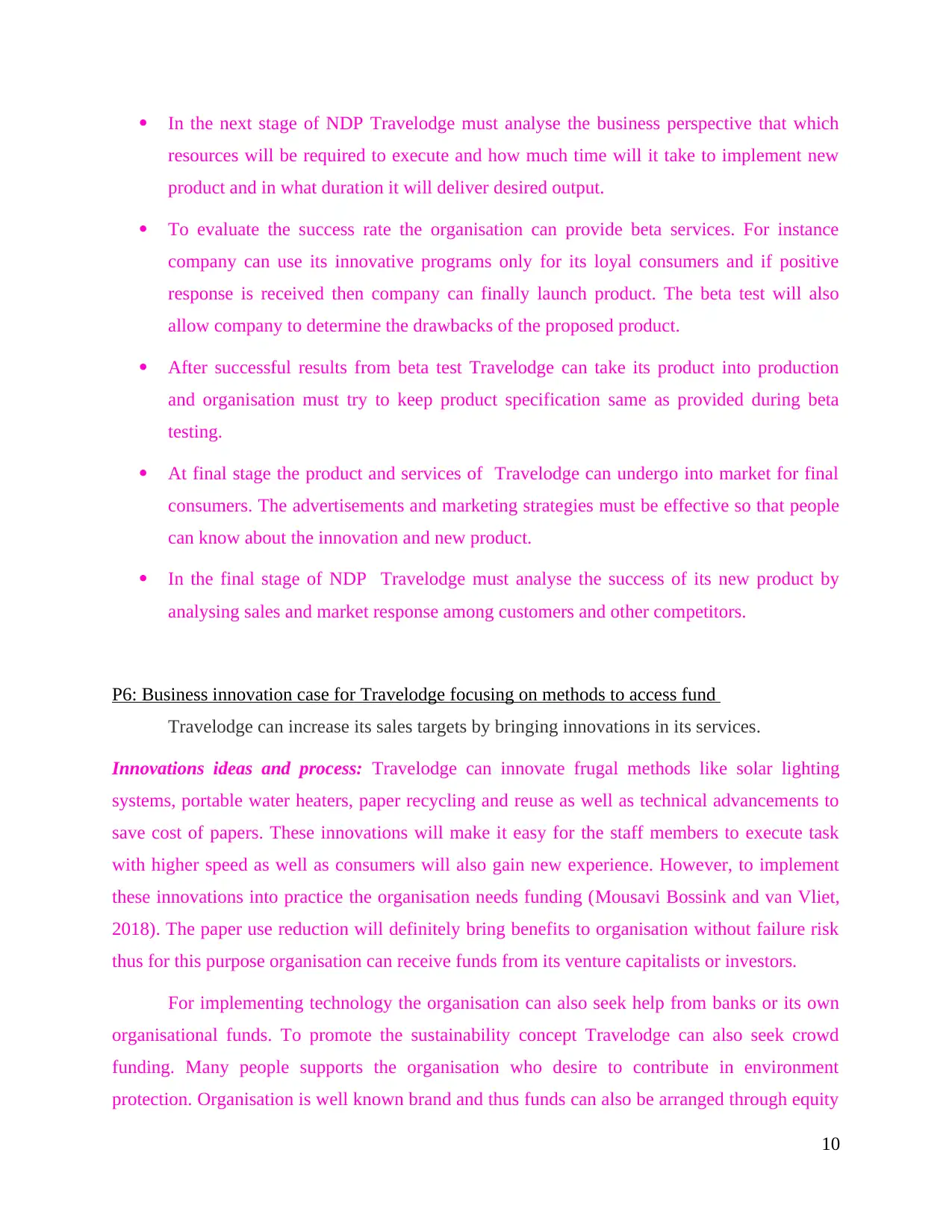
In the next stage of NDP Travelodge must analyse the business perspective that which
resources will be required to execute and how much time will it take to implement new
product and in what duration it will deliver desired output.
To evaluate the success rate the organisation can provide beta services. For instance
company can use its innovative programs only for its loyal consumers and if positive
response is received then company can finally launch product. The beta test will also
allow company to determine the drawbacks of the proposed product.
After successful results from beta test Travelodge can take its product into production
and organisation must try to keep product specification same as provided during beta
testing.
At final stage the product and services of Travelodge can undergo into market for final
consumers. The advertisements and marketing strategies must be effective so that people
can know about the innovation and new product.
In the final stage of NDP Travelodge must analyse the success of its new product by
analysing sales and market response among customers and other competitors.
P6: Business innovation case for Travelodge focusing on methods to access fund
Travelodge can increase its sales targets by bringing innovations in its services.
Innovations ideas and process: Travelodge can innovate frugal methods like solar lighting
systems, portable water heaters, paper recycling and reuse as well as technical advancements to
save cost of papers. These innovations will make it easy for the staff members to execute task
with higher speed as well as consumers will also gain new experience. However, to implement
these innovations into practice the organisation needs funding (Mousavi Bossink and van Vliet,
2018). The paper use reduction will definitely bring benefits to organisation without failure risk
thus for this purpose organisation can receive funds from its venture capitalists or investors.
For implementing technology the organisation can also seek help from banks or its own
organisational funds. To promote the sustainability concept Travelodge can also seek crowd
funding. Many people supports the organisation who desire to contribute in environment
protection. Organisation is well known brand and thus funds can also be arranged through equity
10
resources will be required to execute and how much time will it take to implement new
product and in what duration it will deliver desired output.
To evaluate the success rate the organisation can provide beta services. For instance
company can use its innovative programs only for its loyal consumers and if positive
response is received then company can finally launch product. The beta test will also
allow company to determine the drawbacks of the proposed product.
After successful results from beta test Travelodge can take its product into production
and organisation must try to keep product specification same as provided during beta
testing.
At final stage the product and services of Travelodge can undergo into market for final
consumers. The advertisements and marketing strategies must be effective so that people
can know about the innovation and new product.
In the final stage of NDP Travelodge must analyse the success of its new product by
analysing sales and market response among customers and other competitors.
P6: Business innovation case for Travelodge focusing on methods to access fund
Travelodge can increase its sales targets by bringing innovations in its services.
Innovations ideas and process: Travelodge can innovate frugal methods like solar lighting
systems, portable water heaters, paper recycling and reuse as well as technical advancements to
save cost of papers. These innovations will make it easy for the staff members to execute task
with higher speed as well as consumers will also gain new experience. However, to implement
these innovations into practice the organisation needs funding (Mousavi Bossink and van Vliet,
2018). The paper use reduction will definitely bring benefits to organisation without failure risk
thus for this purpose organisation can receive funds from its venture capitalists or investors.
For implementing technology the organisation can also seek help from banks or its own
organisational funds. To promote the sustainability concept Travelodge can also seek crowd
funding. Many people supports the organisation who desire to contribute in environment
protection. Organisation is well known brand and thus funds can also be arranged through equity
10
⊘ This is a preview!⊘
Do you want full access?
Subscribe today to unlock all pages.

Trusted by 1+ million students worldwide
1 out of 20
Related Documents
Your All-in-One AI-Powered Toolkit for Academic Success.
+13062052269
info@desklib.com
Available 24*7 on WhatsApp / Email
![[object Object]](/_next/static/media/star-bottom.7253800d.svg)
Unlock your academic potential
Copyright © 2020–2025 A2Z Services. All Rights Reserved. Developed and managed by ZUCOL.


![Innovation and Commercialisation Report - Unit 08: [College Name]](/_next/image/?url=https%3A%2F%2Fdesklib.com%2Fmedia%2Fimages%2Fdl%2F5be89891cd83445383609a2cae4964d9.jpg&w=256&q=75)


